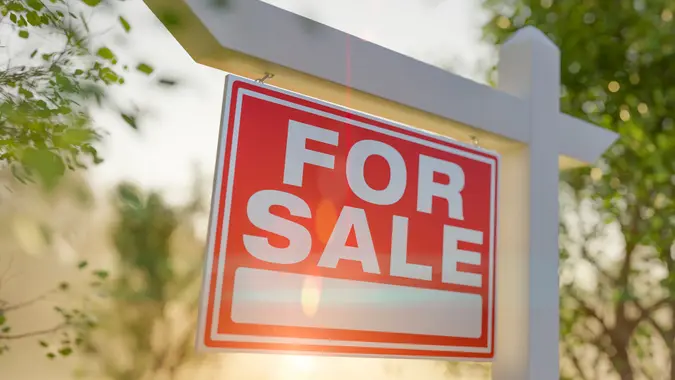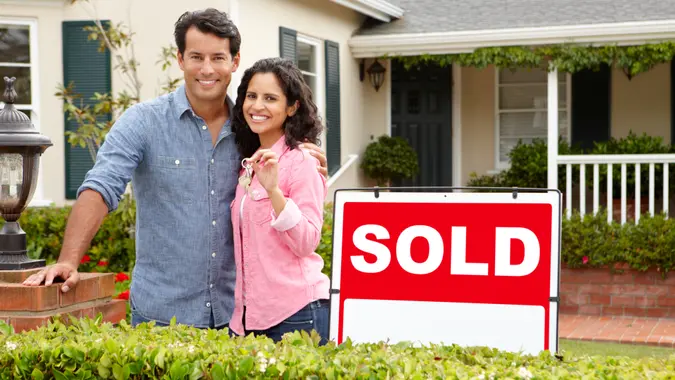Renovated Home or New Construction? How to Find the Better Value in Today’s Market

Commitment to Our Readers
GOBankingRates' editorial team is committed to bringing you unbiased reviews and information. We use data-driven methodologies to evaluate financial products and services - our reviews and ratings are not influenced by advertisers. You can read more about our editorial guidelines and our products and services review methodology.

20 Years
Helping You Live Richer

Reviewed
by Experts

Trusted by
Millions of Readers
President Joe Biden declared this week that June is National Homeownership Month. “I call upon the people of this Nation to recognize the enduring value of homeownership and to recommit ourselves to helping more Americans realize that dream,” Biden said in a proclamation released by the White House. But if you’re in the market for a home, you may be frustrated as existing inventory gets swiped up by eager buyers before you can even schedule a showing at your home of choice.
See: Your Updated First-Time Homebuyers Guide — 9 Tips to Get StartedFind: Houses in These 29 Cities Are Suddenly Major Bargains
“With such little housing inventory, the deck is stacked against buyers and is forcing people to make very expensive decisions very quickly,” says Michael Bourque, CEO of LendingHome, a new resource for real estate investors looking to “fix-and-flip” properties. “To see inventory increase, either demand needs to slow down, or more supply needs to come on the market. In terms of demand, it’s unlikely that we will see a decrease as there are something like 60 million millennials entering their prime homebuying years over the next decade,” he says.
As a homebuyer, you may be considering new construction to alleviate the frustration of having your dream home swept out from under you by a buyer who is either ready with cash or willing to waive appraisal and inspection contingencies to satisfy a seller’s request.
However, Bourque notes that new construction is 15% to 20% more costly than buying a renovated home on the market. LendingHome reports that the median price for a flipped home nationwide sits at $280,000, compared to $330,000 for new construction.
See: How Much Does It Cost to Build a New House?Find: Lumber Prices Have Surged — What Happened and When Will It End?
Hidden Costs to Buying a New Home
The price difference between new construction and older, renovated homes relates to increasing lumber prices driving up construction costs, along with the inherent value of a new home. But buying a new home also comes with additional costs, according to NewHomeSource.com and RocketMortgage. These might include:
- Permit fees
- Design plans
- Land (if not included in overall price)
- Landscaping and landscaping design (if not included in overall price)
- Construction insurance
That isn’t a complete breakdown of construction costs, which include framing, foundation, interior finishes, appliances and everything else that goes into the house. These are just costs that may not be included in the price of the new home — something you don’t have to worry about when you purchase a home from existing inventory.
See: Condo vs. House — Which Option Is Best For You?Find: 17 Dumb Home-Buying Mistakes That Hurt Your Wallet
Plus, you’ll need to budget for continuing your current living arrangements while construction is underway. Also consider closing costs for a mortgage, which you’ll pay whether you buy a new home or existing property.
Construction Delays Plague New Home Sales and Pricing
In addition, you might expect construction delays above and beyond the usual in today’s economic climate. CNBC reported that single-family housing starts dropped by 13% in April, a result of labor shortages and rising lumber prices. Some builders are laying foundations and then waiting to complete construction due to the lack of skilled labor and supply chain issues, CNBC said.
Some builders are even adding “escalation clauses” to their contracts, which means if the cost of materials rises during construction, the buyer is responsible for the added costs, CNBC reported.
See: Housing Demand Is So High That Some Builders Have to Turn Down Jobs
Find: What a $5 Million Home Looks Like Around the US
“If you’re buying a custom home, spec home or builder’s model, you want to make sure that price is guaranteed up front,” says Alec Hartman, CEO of Welcome Homes, a home-building platform that facilitates buyers’ new-construction purchases. “You don’t want to show up to closing and see different numbers on that piece of paper than you were expecting [due to rising costs].”
Environmental Impact of Purchasing New Construction
It’s also wise to consider the environmental ramifications of new construction. TriplePundits.com reported that building a new home produces about as much carbon emissions as five new cars.
However, today’s new homes may be more sustainable than older homes — unless the older houses have been retrofitted with technology like solar panels and energy-efficient doors and windows. Considering that buildings are responsible for 41% of all energy use in the United States, an energy-efficient home can make a big difference in a family’s carbon footprint.
See: Getting a Deal On Home Prices in This Competitive Market — An Expert Weighs InFind: In Tight Housing Market, Buyers Go to Extreme Lengths to Land Homes
Purchasing from Existing Inventory: Buyer Beware
Purchasing an existing home that is in move-in condition can save you time, money and headaches — with a few caveats. You don’t want to take shortcuts in evaluating the condition of the house you’re buying because that could lead to unexpected repair costs.
Experts like Kevin Parker, Vice President, Field Mortgage Originations at Navy Federal Credit Union do not recommend waiving the appraisal and home-inspection contingencies, no matter how much the seller might pressure you. “With it being a seller’s market, in some cases, if you don’t agree to waive the appraisal or home inspection, you may not have the opportunity to buy that particular home. But you want to buy a house you feel comfortable with. There’s a monetary risk to waiving these contingencies,” he says. “If you’re not comfortable waiving them, I do recommend that buyers exercise caution.”
Additionally, homeowners buying an older home should be prepared to put 5% to 7% per year into home repairs, Hartman warns. “Be aware of generalized repair costs,” he says, noting that buyers who intend to view the home as an investment should be prepared to keep areas such as the kitchen and bath up to date with renovations every 10 years.
More From GOBankingRates
 Written by
Written by  Edited by
Edited by 
























